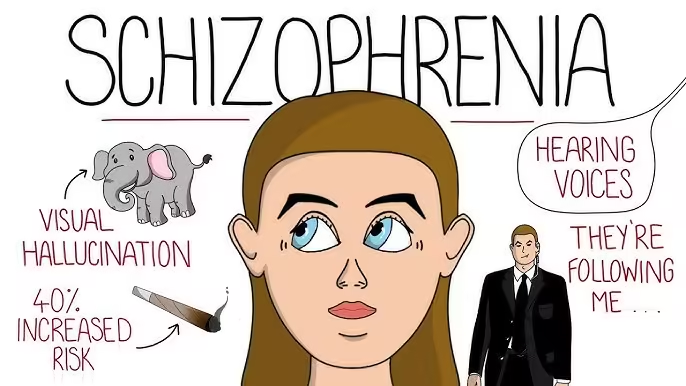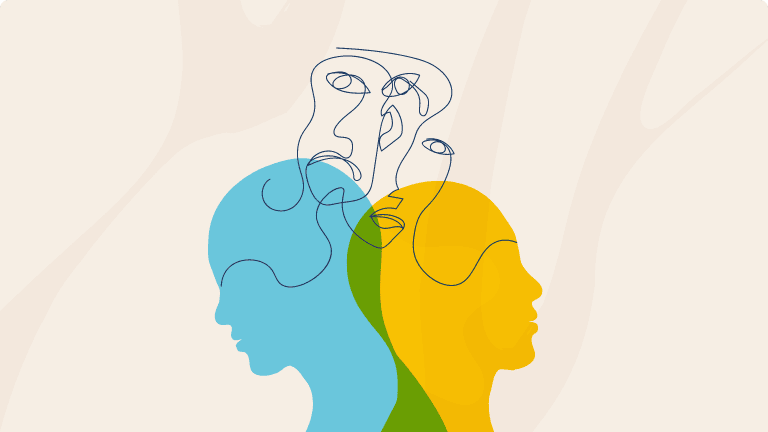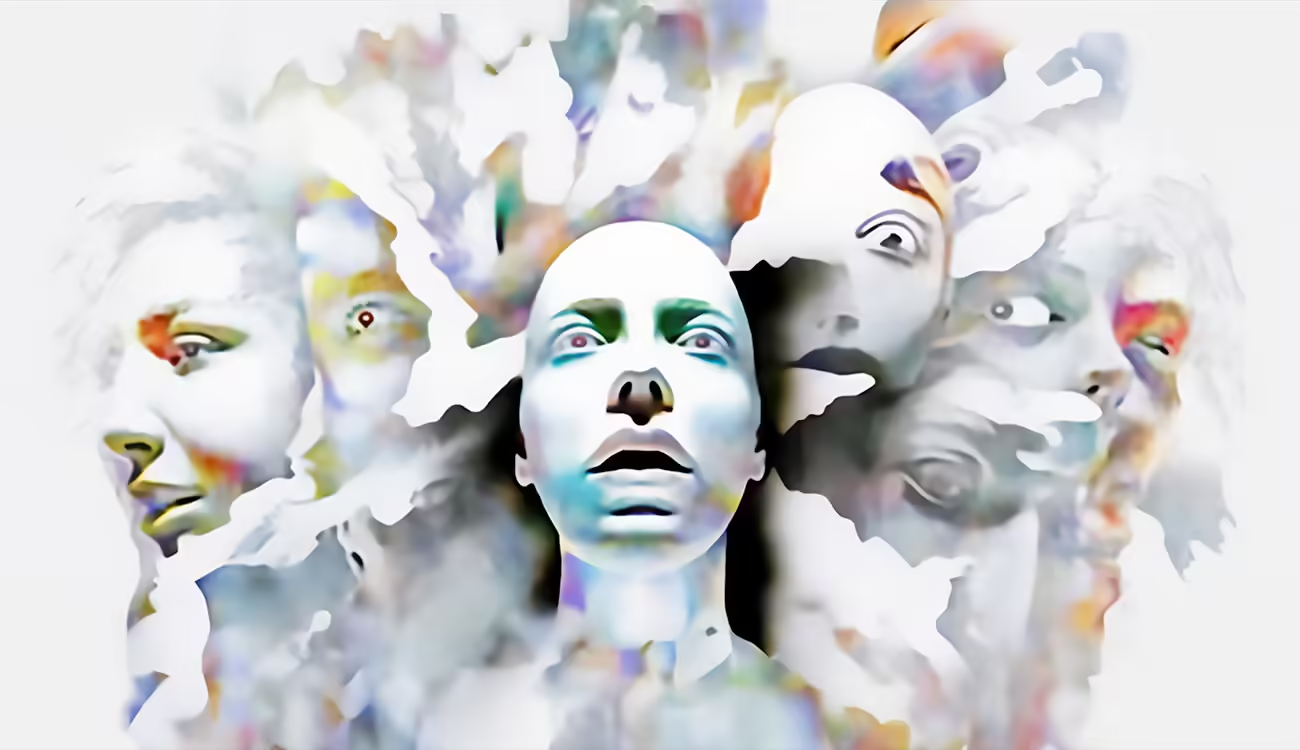Definition of Schizophrenia
Schizophrenia is a severe, progressive psychotic disorder that tends to become chronic, causing patients to gradually withdraw from the external world and retreat into their inner world. Emotional responses become increasingly blunted, work and academic performance deteriorate, and patients may exhibit bizarre and incomprehensible behaviors and thoughts.
Nguyên nhân
Researchers have not yet clearly identified the etiology and pathogenesis of schizophrenia. Experts classify schizophrenia among endogenous disorders, where factors such as genetics, immune response, and toxins play significant roles. Currently, they are focusing research on two areas: genetic abnormalities and neurotransmitter dysfunctions.

Symptoms of Schizophrenia
1. Positive Symptoms
These symptoms are varied and constantly changing, manifesting in all aspects of mental activity, particularly in thought, emotion, and behavior, characterized by discordance.
- Discordance in thought: The patient’s language is often incomprehensible. For instance, they may talk to themselves, not speak at all, or speak very softly. Additionally, they might sometimes talk incessantly or incoherently, repeating words, mimicking others’ voices, or creating new words they only understand. Furthermore, the flow of thought may be slow at times, rapid at others, or suddenly stop. Consequently, their thoughts often lack richness and clarity.
- Discordance in emotion: Emotions become strange, incomprehensible, and lack affection for loved ones. Patients may be indifferent to things they once enjoyed, exhibit contradictory emotions, or display ambivalence.
- Discordance in behavior: Behavior may be impulsive, incomprehensible, contradictory, or bizarre. The patient may withdraw from others, live in isolation, wander, or experience episodes of agitation, shouting, or destructive behavior. Some may exhibit repetitive actions, such as shrugging, smirking, or odd gestures. Others may display eccentric behavior, such as wearing a winter coat on a sunny day or going shirtless in cold weather. They may sometimes sit curled up alone at home and at other times run outside, interfering in others’ affairs.

2. Negative Symptoms:
These are the core manifestations of the schizophrenic process and include:
- Autism: Autism represents a high degree of discordance, characterized by withdrawal from reality, disconnection from the external world, and retreat into an inner life. Specifically, it primarily manifests as a lack of social engagement and strange, incomprehensible behavior. Moreover, the autistic world becomes the patient’s world, where natural and social laws are reversed and no longer applicable.
- Decreased Mental Energy: Mental energy refers to the vitality needed for all mental activities, including enthusiasm, dynamism, flexibility, and creativity. Consequently, a decline in mental energy becomes evident in the patient’s emotional coldness, indifference, and lack of daily emotions. Furthermore, their thoughts become impoverished and rigid, academic performance deteriorates, and old occupational habits gradually disappear. As a result, their willpower declines, leading to a lack of interest in activities, including personal hygiene.
Chẩn đoán
Schizophrenia Diagnostic Criteria according to the Diagnostic and Statistical Manual of Mental Disorders, Fifth Edition (DSM-5)
A. Two (or more) of the following symptoms are present for a significant portion during one month (or less if successfully treated). At least one of the symptoms must be (1), (2), or (3):
- Delusions
- Hallucinations
- Disorganized speech (e.g., incoherence or derailment)
- Grossly disorganized or catatonic behavior
- Negative symptoms (e.g., diminished emotional expression or avolition)
B. For a significant portion of time since the onset of the disturbance, the patient has experienced a marked decline in functioning in one or more critical areas compared to their level of functioning before the onset of the disorder, such as work, interpersonal relations, or self-care.
C. Continuous signs of the disturbance persist for at least six months. This 6-month period must include at least one month of symptoms (or less if successfully treated) that meet Criterion A (active-phase symptoms) and may include periods of prodromal or residual symptoms. During these prodromal or residual periods, the signs of the disturbance may be manifested by only negative symptoms or by two or more symptoms listed in Criterion A in an attenuated form (e.g., odd beliefs, unusual perceptual experiences). During these prodromal or residual periods, the disturbance may present as only negative symptoms or as two or more symptoms listed in Criterion A in a diminished form (e.g., odd beliefs, unusual perceptual experiences).
D. Schizoaffective disorder, depressive disorder, and bipolar disorder with psychotic features have been ruled out because either (1) no major depressive or manic episodes have occurred concurrently with the active-phase symptoms, or (2) if mood episodes have occurred during active-phase symptoms, they have been present for a minority of the total duration of the active and residual periods of the illness.
E. The disturbance is not attributable to the physiological effects of a substance (e.g., a drug of abuse, a medication) or another medical condition.
F. If a history of autism spectrum disorder or childhood-onset communication disorder exists, clinicians should add a diagnosis of schizophrenia only if prominent delusions or hallucinations, along with other required symptoms of schizophrenia, are present for at least one month (or less if successfully treated).
Clinical Subtypes of Schizophrenia:
- Paranoid schizophrenia
- Hebephrenic (disorganized) schizophrenia
- Catatonic schizophrenia
- Undifferentiated schizophrenia
- Post-schizophrenic depression
- Residual schizophrenia
- Simple schizophrenia
Differential Diagnosis
- Schizoaffective Disorder: Both schizophrenic and mood disorder symptoms are prominent simultaneously or within a few days of each other during the same phase of the illness.
- Schizotypal Disorder: Eccentric behavior, odd thinking, and unusual emotions similar to those in schizophrenia, but without the unmistakable and characteristic features of schizophrenia at any stage of the illness.
- Organic Psychosis: In organic psychosis, symptoms similar to schizophrenia may be present, but the full criteria for schizophrenia are not met. Clinical examination and laboratory tests indicate the presence of an underlying organic disease.
- Substance-Induced Psychotic Disorder (e.g., alcohol, drugs): A psychotic state that occurs during or after the use of psychoactive substances. It is characterized by vivid hallucinations (typically auditory, but often involving multiple senses), delusions (usually paranoid), and psychomotor disturbances (agitation or stupor). Abnormal emotions range from intense fear to bewilderment. While this disorder shares many symptoms with schizophrenia, it does not meet the full criteria for schizophrenia. Typically, symptoms will partially resolve within one month and completely resolve within six months. Clinical examination and testing revealed evidence of alcohol or drug intoxication.

Điều trị
Nguyên tắc điều trị
- Schizophrenia is a disease with an unclear etiology, so the treatment primarily focuses on symptom management. Early detection and intervention are crucial.
- Pharmacotherapy plays a vital role, especially for positive symptoms. A combination of multiple treatment modalities is often necessary: psychological therapy, occupational therapy, and social readaptation, particularly for negative symptoms.
- Monotherapy is preferred; however, if there is a poor response or no response, combination therapy with two different antipsychotics may be used. Avoid combining three or more antipsychotics.
- Close monitoring of the medication regimen is essential to detect and manage the side effects of antipsychotics promptly.
- Maintenance therapy after the first psychotic episode and community-based management and monitoring are essential for preventing relapse.
- Rehabilitation is essential, particularly for negative symptoms.
- Educating families and communities to change their attitudes towards patients with schizophrenia is necessary (avoiding stigma and social isolation). Close cooperation between healthcare providers, families, and communities is crucial in patient care.
- Timely identification and management of factors that could trigger relapse are essential.
Pharmacotherapy
Classic antipsychotics: Haloperidol, Levomepromazine, Chlorpromazine
New antipsychotics: Risperidone, Olanzapine, Clozapine, Quetiapine
Adjunctive therapy: Depending on the specific case, adjunctive treatment may include:
- Beta-blockers: Propranolol
- Antidepressants: Amitriptyline, Sertraline, Duloxetine
- Mood stabilizers: Carbamazepine, Oxcarbazepine, Divalproex
Electroconvulsive Therapy (ECT) and Transcranial Magnetic Stimulation (TMS)
ECT is effective in some instances (catatonia, suicidal ideation, and behavior due to depression, delusions, hallucinations, or agitation that is poorly responsive to pharmacotherapy).
Psychotherapy
There are various psychotherapeutic approaches (individual, family, group therapy), with behavioral therapy being vital for patients with schizophrenia. Support groups may be established to provide support for patients and their families.
Occupational Therapy and Rehabilitation
The principle is to engage patients in activities at a level they can achieve to rebuild their self-confidence.
Gradually increase the activity level according to the patient’s capacity without causing undue stress.
Vocational rehabilitation should consider the social, economic, and cultural environment in which the patient lives.
Phòng ngừa
Since the exact cause of schizophrenia remains unclear, no absolute prevention method exists.
Encourage children to develop a sense of community and teach them how to adapt to their environment and life’s challenges.
Monitor individuals with a genetic predisposition to schizophrenia (such as those with parents, grandparents, siblings, or close relatives who have the condition) to ensure early detection and timely intervention.
Educate patients and their families about the disease, the factors that can trigger a relapse, and the importance of cooperating and adhering to treatment.
Healthcare providers must continue to follow up with patients after discharge, persistently providing maintenance treatment. They should also identify risk factors early and proactively treat infectious or physical illnesses to prevent relapse.

